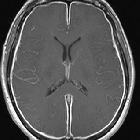bacterial meningitis

Pyogenic meningitis, also referred as bacterial meningitis, is a life-threatening CNS infectious disease affecting the meninges, with elevated mortality and disability rates. Three bacteria (Haemophilus influenzae, Streptococcus pneumoniae, Neisseria meningitidis) account for the majority of cases .
Epidemiology
The epidemiological spectrum of pyogenic meningitis has changed in the last two decades in some countries due to routine vaccination. Largely the use of the H. influenzae type b (Hib) conjugate vaccine for infants and the heptavalent protein-polysaccharide pneumococcal conjugate vaccine (PCV7) are good examples that explain the significant reduction on H. influenza and pneumococcal disease incidences. Near elimination of serogroup C meningococcal meningitis and H. influenzae meningitis has been documented in wealthy nations .
The median age at diagnosis of bacterial meningitis has increased in the last decades as a result of children vaccination, although infants under 2 months of age have not experienced this incidence reduction .
It is important to note that chronic and immunocompromising conditions are common predisposing factors for bacterial meningitis among adults, including :
- elderly patients (>65 years)
- splenectomy and hyposplenic state
- alcoholism
- HIV/AIDS
- diabetes mellitus
- cancer
- anatomical defect (related with recurrent meningitis)
- organ transplant recipients
Clinical presentation
In older children and adults there are typical symptoms and signs, such as: fever, headache, stiff neck, committing and mental dysfunction ranging from lethargy to coma. The signs are less clear in infants, being related to non-specific signs of sepsis and seizures .
The diagnosis is usually confirmed by lumbar puncture.
Pathology
Bacteria may arise at the CNS as a result of direct implantation, contagious infection from a local septic process (e.g. sinusitis) or an infected foreign body (e.g. a shunting catheter), or by haematogenous spread .
Etiology
- group B streptococcus (GBS): the major cause of bacterial meningitis in infants under 2 months of age
- Neisseria meningitidis: the major cause of bacterial meningitis in older children and young adults
- Streptococcus pneumoniae: the most common pathogen in adults
Radiographic features
As the response to these insults are limited and follows a stereotypical fashion, the imaging findings are mostly nonspecific with respect to the causative pathogen. Nevertheless, imaging findings are helpful in detecting an abnormality and making differential diagnosis with other noninfectious causes .
CT and MRI
- Over all cross sectional imaging is not sensitive or specific for diagnosing meningitis
- Reported CT findings include sucal effacement and slight hyperattenuation on NECT but false positives are common.
- Regarding MRI there may be increased FLAIR signal relative to normal cortex but this is also not specific for meningitis. On post contrast MRI the most common positive findings are thin and linear leptomeningeal enhancement (however only seen in 50% of patients). More specifically, if seen, smooth or linear enhancement is more characteristic of acute pyogenic (bacterial) and lymphocytic viral meningitis. If a more nodular thick enhancement pattern is seen especially involving the basal cisterns, Leptomeningeal carcinomatosis or granulomatous disease is more likely.
- Other findings on MRI may include cerebral sulcal restricted diffusion relative to normal cortex.
Treatment and prognosis
Empirical antimicrobial therapy for purulent meningitis is guided by the age of the patient .
The adult case fatality has a straight correlation with increasing age, the overall rate is estimated at around 16% in the USA, ranging from ~9% among patients 18 to 34 years of age vs. ~23% among those older than 65 years .
Complications
The complications of meningitis can be remembered using the mnemonic HACTIVE :
- H: hydrocephalus
- A: abscess
- C: cerebritis / cranial nerve lesion
- T: thrombosis
- I: infarct
- V: ventriculitis / vasculopathy
- E: extra-axial collection: empyema and hygroma
Differential diagnosis
- fungal meningitis: usually exhibit a thicker, lumpy or nodular enhancement
- viral meningitis
Siehe auch:
und weiter:

 Assoziationen und Differentialdiagnosen zu bakterielle Meningitis:
Assoziationen und Differentialdiagnosen zu bakterielle Meningitis:

